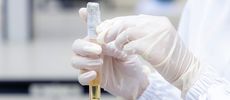Electricity-Based Water Purification Streamlines Treatment


No matter where you are across the globe, treating drinking water calls for a similar toolkit—chlorine or other disinfecting chemicals, multiple layers of filtration, and high-pressure membranes when needed. These methods work well, but they require handling chemicals, maintaining and replacing filters, and managing the environmental impact of waste and byproducts.
This has led researchers and engineers to explore a different approach. Enter: electricity-based water purification.
This method trades chemicals and filtration systems for electrical or magnetic fields. The result is a simplified, sustainable process for removing contaminants that can scale for both large utilities and small community systems.
Pilot projects and lab studies show that electricity-based approaches can be powerful for producing high-quality, safe water. By delivering precise bursts of energy or creating reactive cleaning agents in the water itself, these systems use minimal power to target germs, break down pollutants, and even reduce scaling in pipes without producing excess waste.
Let's take a closer look at the benefits of electricity-based water purification, several methods that show promise, and what the future might hold for the technology.
Advantages of Electricity-Based Water Purification
One major benefit of electricity-based water treatment is the elimination of chlorine or other chemicals from the disinfection process. This reduces the need for storing, handling, and transporting potentially hazardous materials and avoids creating chemical byproducts that can affect taste, smell, or safety.
Speed and flexibility offer another potential advantage in favor of electricity-based water purification. Many techniques can disinfect water in seconds, making them useful in both emergencies and daily operations. Engineers can adapt the same core technology for different applications, from small units for remote households to larger systems serving entire communities.
Maintenance with electricity-based systems may also be easier, as these systems rely on electrical energy rather than consumable parts. This method eliminates time-consuming, waste-producing processes, such as filter changes, membrane cleanings, and chemical dosing schedules. With little waste or environmental impact, electricity-based purification could help water providers meet public health and sustainability goals. That said, the new method will still require large amounts of electricity.
However, electrically purified water may change test requirements by shifting the focus from general chemical and microbial analysis to specific parameters that depend on the method used. The tests will need to verify that the process was effective and didn't introduce new contaminants or byproducts.
How Does Electricity Clean Water?
Electricity-based water treatment works by changing water in ways that eliminate harmful organisms or contaminants—whether that means damaging bacteria so they die or producing powerful cleaning agents. Here are four of the most promising processes.
1. Locally Enhanced Electric Field Treatment (LEEFT)
In LEEFT systems, water flows past specific surfaces or materials that concentrate an electric charge in tiny areas to initiate the process of electroporation. As the name implies, the LEEFT method uses a strong electric field to create pores in microbial cell membranes, deactivating them.
For example, metallic nanowires can enhance the electric field at the tips of structures designed for water disinfection. When bacteria pass through, the electric field damages them to the point that they can no longer survive or reproduce.
The LEEFT process is simple, low-cost, low-power, and requires no chemicals. That said, it does come with its own set of challenges, including mechanism tuning and byproduct formation.
2. Pulsed Electric Field (PEF) Treatment
PEF is another treatment technique based on electroporation. PEF treatment sends short bursts—similar to camera flashes—through water. These concentrated bursts are strong enough to destroy bacteria and other microorganisms.
Because the bursts are brief, the process uses low power that doesn't heat the water. In lab tests, low-voltage pulses have removed more than 90% of common bacteria like E. coli from water without adding any chemicals.
However, the upfront cost for this treatment is high. Additionally, it has questionable large-scale efficacy and may require numerous repeat treatments.
3. Electromagnetic Field (EMF) Treatment
Operators often use EMF treatments in large cooling towers or industrial water systems. EMF sends electromagnetic pulses into the water to keep minerals from sticking together and forming hard deposits. In addition, EMF can make conditions inhospitable for certain bacteria, reducing the need for chemical scale removers and biocides.
EMF is a non-chemical treatment primarily used for reducing membrane fouling and scaling in reverse osmosis systems and elsewhere to prevent scale formation and control biological growth.
Still, producing consistent results through this method can be a challenge.
4. Electrochemical and Plasma Discharge Systems
Electrochemical and plasma discharge systems use an electric current or spark to create powerful cleaning agents—like ozone or specific radicals—directly in the water. These agents break down harmful chemicals and kill bacteria, then quickly revert to harmless substances. Tests with special carbon-based electrodes have shown that these systems can clean tap water and remove harmful bacteria without leaving any chemical residue.
Methods include the following:
- Electrocoagulation: Removes suspended solids and pollutants by generating metal hydroxide coagulants from electrodes.
- Electrodialysis and electrodialysis reversal: Desalinates water by separating ions using ion-exchange membranes driven by an electric field.
- Electro-oxidation and electro-reduction: Degrades organic pollutants and reduces contaminants like heavy metals or nitrates.
The methods are highly efficient, insensitive to toxic compounds, and generate little secondary waste. However, the capital cost can be high. Additional concerns include energy consumption, byproduct formation, and the price, lifespan, and toxicity of electrode materials.
The Future of Electrified Water Treatment
Researchers are still testing many of these systems in labs or pilot projects, but the results demonstrate the potential of electricity-based water purification. As engineers refine the designs and costs drop, electricity could join the list of reliable tools for making water safer—giving everyone from villages miles from high-quality water sources to utilities serving thousands of people hope for cleaner, safer water without chemicals, filters, waste, or byproducts.






